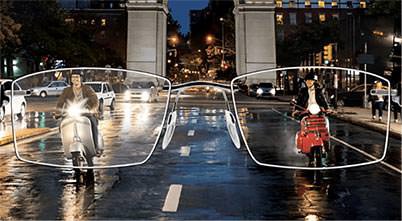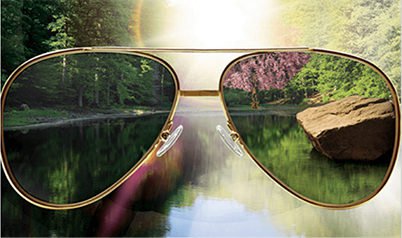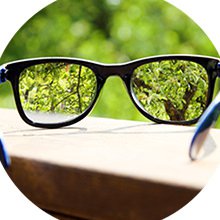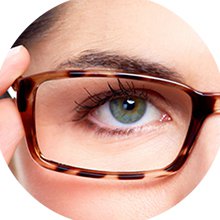









Types of Lenses
Lenses are the most important element in the process of selecting eyeglasses. Our professionals will evaluate your prescription, conditions, occupation, and lifestyle to recommend the perfect lens for you.

Single Vision Lenses
Single vision lenses are prescribed if you need correction for one field of vision, whether for distance, intermediate, or close up. Single vision lenses have the same optical focal point or correction over the entire area of the lens.
There are many options available for single vision lenses, including ultra-light material, high impact-resistant material, a combination of both, or simply an ordinary plastic lens. Our experts can guide you to the right type for you.

Progressive Lenses
Our eyes are tasked with seeing things at all depths of vision, from far away to near to us. As we reach middle age, it often becomes more difficult to adjust focus from one range of vision to another. Progressive lenses are "multifocal." In other words, these lenses correct more than one vision condition, with their focal power “progressing” from top to bottom.
Progressive lenses are used for seeing clearly across all distances, with a seamless transition between objects both up close and far away. Today’s progressive lenses appear clear throughout, without the lines associated with bifocal lenses.

No-Glare Lenses
No-glare lenses provide superior vision by reducing the effects of glare, smudges, water, dust, dirt, and UV rays. They can also fight digital eyestrain and even prevent headaches by diminishing glare from electronic devices such as cell phones and computer screens.
Your eyesight naturally suffers at night, with reductions in depth perception, peripheral vision, and color recognition. This is particularly noticeable when driving due to the glare from streetlights or oncoming headlights. No-glare lenses reduce this dangerous glare, giving you better vision and a safer driving experience.

Polarized Lenses
Light reflecting off of water or a flat surface can cause unwanted glare, leading to eye fatigue. This can become a huge problem for people who enjoy boating, fishing, or other water-based activities. What’s the solution? Polarized lenses reduce reflected sun glare from many surfaces, particularly water, allowing you to perform your favorite activities without the burden of tired, achy eyes.

Photochromic Lenses
Throughout the course of your day, you likely move in and out of bright, sunny areas to darker indoor areas. Photochromic lenses are eyeglass lenses that are clear (or nearly clear) indoors, but that darken automatically when exposed to sunlight, helping shield your eyes from the sun’s harmful UVA and UVB rays. They are available in nearly all lens materials, including high-index lenses and progressive lenses.

Polycarbonate Lenses
Polycarbonate lenses are thinner and lighter than standard plastic varieties, and they are also much more durable. Polycarbonate is ideal for individuals with high prescriptions because they correct vision without adding as much thickness as conventional plastic lenses, which can distort the wearer’s appearance. Best of all, polycarbonate lenses are 10 times more impact-resistant than glass or regular plastic lenses, and they exceed the FDA’s impact resistance requirements by more than 40 times. Because they’re virtually unbreakable, they make a great choice for children and active adults.

High-Index Lenses
High-index lens material allows even those with strong prescriptions to enjoy lightweight lenses with an attractively thin profile and minimal eye distortion. They are thinner than conventional lens materials because of high-index’s ability to more efficiently bend light. High-index lenses are typically more expensive than standard plastic and mid-index varieties, but they increase the range of frame choices for people with strong prescriptions by reducing the bulk of the lens.

Aspheric Lenses
“Aspheric” refers not to a material, but to a type of lens curvature. These lenses differ from conventional lenses because they are not shaped the same on the front of the lens, and this altered curvature reduces lens weight, lens thickness, and eye distortion. Aspheric lenses are great for reducing thickness, and especially for reducing eye distortion as seen from the outside. Choosing aspheric high-index lenses is one of the best ways to get extremely thin and attractive lenses, although you’ll pay more compared to conventional lenses and not all frame options will be available.

